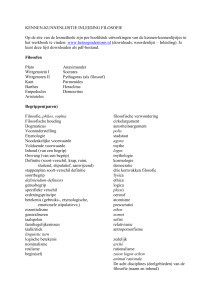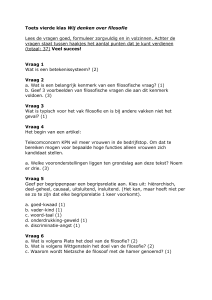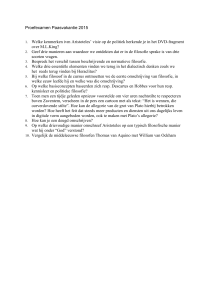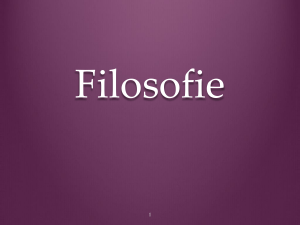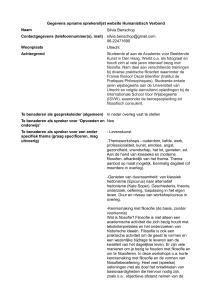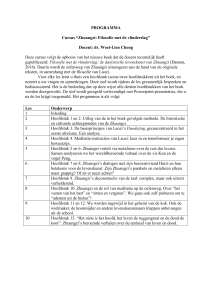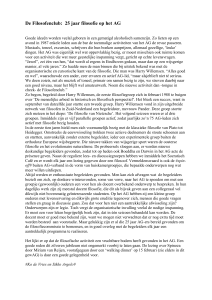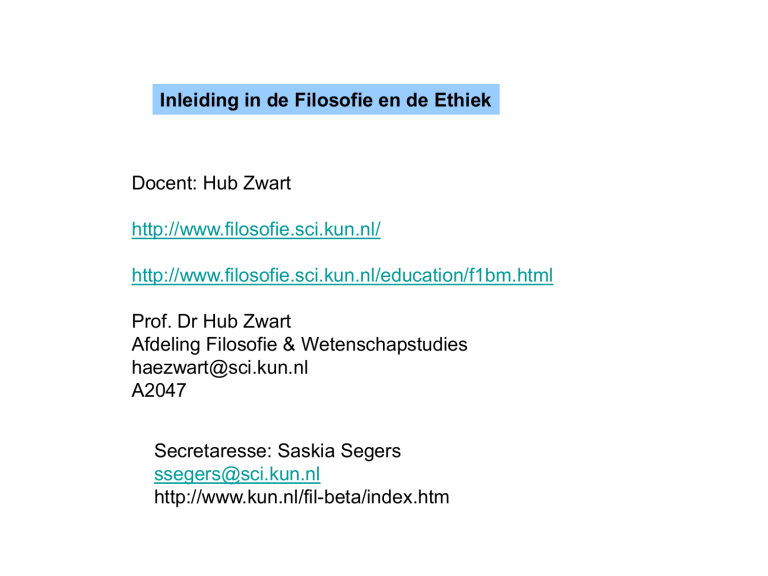
Inleiding in de Filosofie en de Ethiek
Docent: Hub Zwart
http://www.filosofie.sci.kun.nl/
http://www.filosofie.sci.kun.nl/education/f1bm.html
Prof. Dr Hub Zwart
Afdeling Filosofie & Wetenschapstudies
[email protected]
A2047
Secretaresse: Saskia Segers
[email protected]
http://www.kun.nl/fil-beta/index.htm
Filosofie: een kritische of normatieve
wetenschap
Wetenschapsfilosofie: kritisch onderzoek naar de
betrouwbaarheid van wetenschappelijke
kennisclaims
Ethiek: normen voor omgang met proefpersonen,
proefdieren, milieu, kennis, informatie, schaarse
hulpbronnen, etc.
Education / Onderwijs
prof. dr Hub Zwart KUN FNWI
Education
Research
C.V.
Publications
Bibliographies
Links
Filosofie 1
Inleiding in de Filosofie en de Ethiek
Voor Studenten "Levenswetenschappen"
(Biologie, Moleculaire Levenswetenschappen en
Milieu-wetenschappen)
Opzet
Overzicht
College-dictaten
Opdrachten
Education
Datum
Opzet
Overzicht
College-dictaten
Opdrachten
I. Dierfilosofie
1
16.4
Dierfilosofie
2
16.4
Dierethiek
II. Milieufilosofie
Wat is filosofie?
Wat is ethiek?
Onderwerp
3
14.5
Natuurbeelden
4
28.5
Milieu-ethiek
III. Biotechnologie
5
4.6
Angst voor wetenschap
6
11.6
Voedselethiek
7
18.6
Biotechnologie
8
25.6
Genomics
“Natuurlijke historie”
± 1800 – “biologie”
Observeren
Classificeren
Speculeren
Laboratorium-onderzoek
Modelorganismen
“actief observeren”
Aristoteles (384 - 322 v Chr)
“An animal with lungs, even a tortoise or a
frog, if one holds it under water too long, it
will be drowned. But it does not happen in
the case of fishes, try as we will”
Aristotle, “On Respiration”
René Descartes (1596-1650)
William Harvey (1578 - 1657)
Albrecht von Haller (1707-1777)
Johannes Peter Müller (1801 – 1858)
Claude Bernard (1813-1878)
We must painfully acknowledge that, precisely because
of its great intellectual development, the best of man’s
domesticated animals - the dog - most often becomes
the victim of physiological experiments. It is extremely
touching. The dog is almost a participant in the
experiments conducted upon it, greatly facilitating the
success of the research by its understanding and
compliance (Pavlov 1893)
"When I dissect and destroy a living animal, I hear within
myself a bitter reproach that with rough and blundering
hand I am crushing an incomparable artistic mechanism. But
I endure this in the interest of truth, for the benefit of
humanity"
"this method was adopted as a result of a hint given by
one of the dogs subjected to the operation. We (dr.
Kuvshinski and I) gratefully acknowledge that by its
manifestation of common sense the dog has helped us as
well as itself”
“I regard the promotion of our surgical technique to be
a matter of greatest importance, because the usual
method of simply vivisecting the animal in an acute
experiment is, as is now becoming clearer day by day, a
major source of error, since the act of crude violation of
the organism is accompanied by a mass of inhibitory
influences on the functions of the different organs. The
organism as a whole, the realization of the most
delicate and most expedient linking of an enormous
number of separate parts, cannot, in the nature of
things, remain passive to destructive agents”
“The desire ... to spare our experimental animals as much as
possible made us stricktly observe all the precautions taken by
surgeons in respect to their patients”
"Our healthy and happy animals did their laboratory work
with real gusto; they always rushed from their cages to
the laboratory and readily jumped on the tables where
our experiments and observations were conducted.
Believe me I am not exaggerating a iota. Thanks to our
surgical method in physiology we can demonstrate
[phenomena of digestion] without a single scream from
the animal undergoing the experiment”
“In almost all biological experiment, particularly in
hormone research, the rat has made a place of honour
for itself. Because of its cooperation, though
involuntary, he has contributed to countless and
important successes. I feel that I am not only fulfilling
a debt of gratitude towards the rat but contributing
something towards its rehabilitation and recognition by
taking this opportunity to protest against the prejudice
of the public towards these, my favourite test animals,
and I would like to convert my readers from the
abhorrence in which these really inoffensive little
animals and their habits are so often held” (Eugene
Steinach)
“Pavlov cultivated the image of laboratory
dogs that, after recovering from the
surgical operations, led normal, ‘happy’
lives. The reality was somewhat different.
Many dogs died and survivors usually
developed fatal conditions...
Whether or not they were happy and normal, they
lived much longer than those consumed in acute
experiments and this facilitated a relationship with
experimental dogs that sometimes resembled that
between pet and master” (Daniel Todes, 2002, p. 98).
Wistar-rat (Rattus Norvegicus)
Immanuel Kant (1724 - 1804)
Antropocentrisme
“Fiat experimentum in corpore vili”
Instrumentele en intrinsieke waarde
“Handel zo dat je de ander niet alleen als middel
beschouwt, maar altijd ook als persoon (subject)
respecteert”
Russell & Burch 1959
Vervang
Verminder
Verfijn
Replace
Reduce
Refine
Dierenlaboratorium
Dierexperimentencommissie
DEC
“Ongerief proefdier” versus “Maatschappelijk of
wetenschappelijk belang”
Eduardo Kac - Alba
Glowfish
Integriteit
Intrinsieke waarde
Verslaving
Een onderzoeksgroep wil het verband onderzoeken tussen
traumatische jeugdervaringen (zoals emotionele verwaarlozing
op jonge leeftijd) en de incidentie van verslaving aan alcohol of
drugs. Daartoe willen ze gebruik maken van proefdieren. Het
gaat om 40 ratten (20 ratten in de controle-conditie, 20 ratten
in de experimentele conditie). De ratten in de controle-conditie
groeien op bij hun moeder. Hun soortgenoten in de
experimentele conditie worden op jonge leeftijd van hun
moeder gescheiden. Wanneer de dieren volwassen zijn, worden
ze in een speciale kooi geplaatst waar ze zich zelf met behulp
van een pedaaltje alcohol of cocaïne kunnen toedienen. De
hypothese is dat ratten in de experimentele conditie sneller
verslaafd zullen raken dan ratten in de experimentele conditie.
Na 3 weken worden de dieren gedood met het oog op
anatomisch onderzoek van relevante hersengebieden. Ze
leggen hun protocol voor aan de DEC en benadrukken het
maatschappelijke belang van hun project. Verslaving is immers
een ernstig (en kostbaar) maatschappelijk probleem. Ze
vewachten dat hun onderzoek de mogelijkheden voor preventie
zullen bevorderen.

